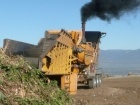Feb 16 2009
The Swiss Chemical Society presented its prestigious Sandmeyer Prize to a team of Empa researchers, this award being given annually in recognition of outstanding work in the field of applied chemistry. The Empa team investigated the chemical processes which take place during the catalytic decomposition of soot in particle filters used to treat diesel engine exhaust gas. Under certain conditions carcinogenic or genetically damaging substances can be created. The results of the Empa scientists' work provide important information which indicates the way forward in further developing the filtering technology.
 Modern filtering systems are even capable of detoxifying heavy truck exhaust gas effectively. Empa researchers were able to demonstrate that the chemical processes at work in correctly functioning filters produced no harmful substances, the first time that this has been confirmed beyond doubt.
Modern filtering systems are even capable of detoxifying heavy truck exhaust gas effectively. Empa researchers were able to demonstrate that the chemical processes at work in correctly functioning filters produced no harmful substances, the first time that this has been confirmed beyond doubt.
Deep within the Gotthard Massif huge machines are boring their way through layers of alpine rock, creating the tunnels for the New Railway link through the Alps or NRLA. The tunneling work is difficult, and not just from a geological perspective either. The necessity of protecting hundreds of workers in the 57km long tunnel shafts from the poisonous exhaust gases emitted by the tunneling and earth moving plant was a serious challenge which threw up a raft of previously unanswered question. The approval of the NRLA project in a referendum of Swiss voters triggered the work of an interdisciplinary team of Empa researchers. Norbert Heeb, Andrea Ulrich, Lukas Emmenegger and their colleagues took on the task of investigating which chemical processes take place in soot-filled particle filters.
Modern filters extract some 99 per cent of the nanometer-sized soot particles from the exhaust gases of diesel motors used in automobiles, lorries, rail locomotives, tractors, ships and earth moving vehicles. In doing so they significantly reduce the fine particle pollution in the atmosphere. However, gaseous compounds in the exhaust also react with the catalytic surfaces of such filters. Are these pollutants also decomposed efficiently? Or are new ones actually created in the device? The relevance of this question becomes clear when we realize that certain aromatic carbon compounds found in diesel exhaust are considered to be carcinogenic or to cause genetic damage in humans.
Filter systems win over the chemists
“When we first started thinking about diesel particle filters we weren’t really sure if it was right to encourage this technology and call for it to be used more widely”, says Norbert Heeb. “After all, during the soot decomposition process extremely dubious substances – even including dioxins or toxic hydrocarbons – are produced.” Since then, however, the researchers have evaluated numerous well-functioning filter systems, so that now they can give their “full support to this new environmental technology.”
In order to make a comprehensive analysis of the benefits and possible risks associated with different filter technologies, Empa has assembled an interdisciplinary team of chemists, biologists, engineers and environmental scientists. They were able to show that, depending on the catalyst material, the creation of secondary toxic side products is, in principle, possible. In certain filter systems nitroaromatics or polychlorinated dibenzodioxines and furanes (PCDD/F) were in fact produced, though in these cases the kind of catalytically active metal involved played a central role.
Good filters decompose pollutants
So far it has all been bad news. The good new is that many filter systems can be operated in a way that minimizes these risks. Even better, catalytic filter systems can actually decompose genetically harmful substances, so that not only are soot particles removed from the diesel exhaust, but the gas is also significantly detoxified.
This work has been performed with the cooperation of the filter and catalyst manufacturers, and the research results have been directly used in furthering the development of the technology, leading to the creation of more efficient particle filters completely devoid of “side-effects”.
Within Switzerland as well as internationally, the results of the Empa research team have been met with a great deal of interest. Significant parts of the “VERT” Qualification Tests for particle filter systems are based on the group’s work, “VERT” being the acronym in German for “reducing the emissions of real diesel motors during tunnel boring”. An associated standard which has been published, SNR 277205, forms the basis for modifications to the Swiss Clean Air Act (LRV).
“Our research work is very practically oriented”, says Heeb. «Perhaps this is what convinced the jury to award us the Sandmeyer Prize. We were very surprised and of course extremely pleased to be recognized in this way.”